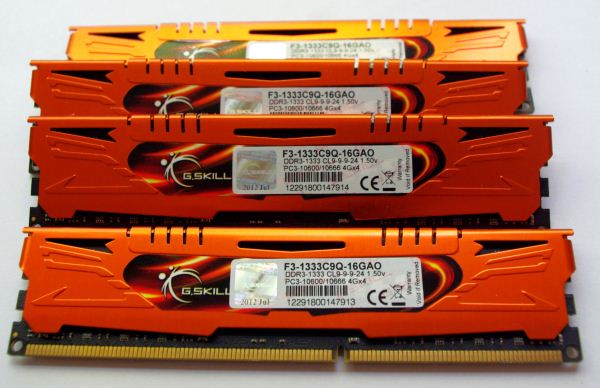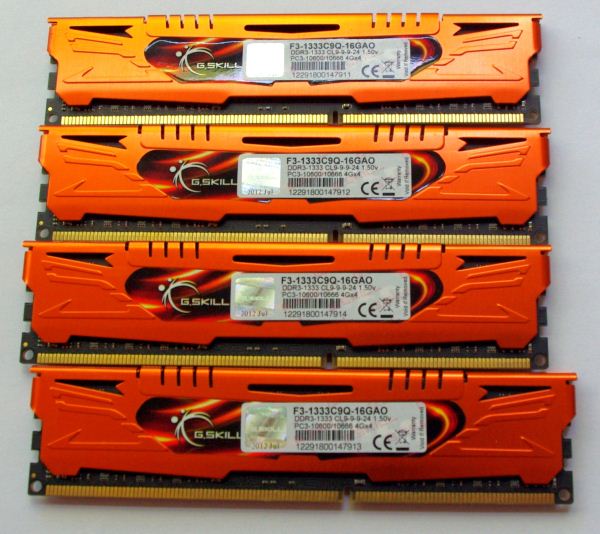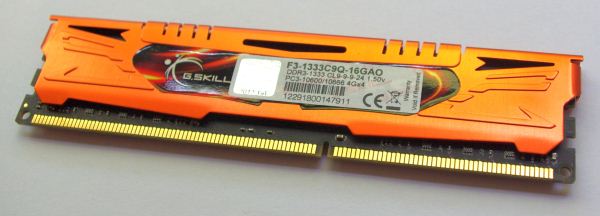Memory Performance: 16GB DDR3-1333 to DDR3-2400 on Ivy Bridge IGP with G.Skill
by Ian Cutress on October 18, 2012 12:00 PM EST- Posted in
- Memory
- G.Skill
- Ivy Bridge
- DDR3
At the lowest end of our testing, we have a 16GB DDR3-1333 9-9-9 kit on hand. When DDR3 was first released, the main speed available was DDR3-800, but enough time has passed that this has phased out and now 1333 MHz is the new ‘minimum’. With the prices of memory as they are, this kit from G.Skill currently retails for $75, meaning that a massive amount of memory is available for all at a reasonable level. To put this into contrast, I remember spending ~$240 on a 2x2 GB Kit of DDR2-800 5-5-5 about 5-6 years ago – we can now get four times the capacity for less than a third of the price.
DDR3-1333 sits at the bottom end, but within months we can imagine DDR3-1600 taking that spot – as we will see with the next kit, for $5 more we get a faster product.
Visual Inspection
Our first kit features G.Skill’s Ares branding – the Ares kits that G.Skill sell are essentially meant to be the lower profile but colored heatsinks. These heatsinks in all honesty may not be entirely necessary for cooling, but they are firmly bonded to the memory modules and removing them would be a large task and more than likely damage the module. I have seen horror stories of chips being removed along with the heatsink, making the memory unusable. As a result we cannot directly observe which ICs are being used in our kits for this review. A quick word in the ear of G.Skill and they will not tell us the information, under the guise that it is classified and if the competition wants to know what G.Skill are using, they will have to buy a kit and break it themselves. Given how small the margins are in memory sales (as well as potential market stagnation after the credit crisis), I’m not surprised with the level of secrecy.
Anyway, back to the kit:
The standard packaging at G.Skill is a rather efficient plastic container holding each of the modules. The packaging is easy enough to open, though I also found it fairly brittle, meaning small shards could break off and be easily lodged in feet. Inside the box itself is a piece of card to advertise the kit and protect the modules from each other. We also get a small G.Skill sticker for the computer case.
JEDEC + XMP Settings
| G.Skill | |||||
| Kit Speed | 1333 | 1600 | 1866 | 2133 | 2400 |
| Subtimings | 9-9-9-24 2T | 9-9-9-24 2T | 9-10-9-28 2T | 9-11-10-28 2T | 10-12-12-31 2T |
| Price | $75 | $80 | $95 | $130 | $145 |
| XMP | No | Yes | Yes | Yes | Yes |
| Size | 4 x 4 GB | 4 x 4 GB | 4 x 4 GB | 4 x 4 GB | 4 x 4 GB |
|
|
|||||
| MHz | 1333 | 1600 | 1867 | 2134 | 2401 |
| Voltage | 1.500 | 1.500 | 1.500 | 1.650 | 1.650 |
| tCL | 9 | 9 | 9 | 9 | 10 |
| tRCD | 9 | 9 | 10 | 11 | 12 |
| tRP | 9 | 9 | 9 | 10 | 12 |
| tRAS | 24 | 24 | 28 | 28 | 31 |
| tRC | 33 | 33 | 37 | 38 | 43 |
| tWR | 10 | 12 | 14 | 16 | 16 |
| tRRD | 4 | 5 | 5 | 6 | 7/6 |
| tRFC | 107 | 128 | 150 | 171 | 313 |
| tWTR | 5 | 6 | 8/7 | 9/8 | 10/9 |
| tRTP | 5 | 6 | 8/7 | 9/8 | 10/9 |
| tFAW | 20 | 24 | 24 | 25 | 26 |
| tCWL | - | 7 | 7 | 7 | 7 |
| CR | - | 2 | 2 | 2 | 2 |






















114 Comments
View All Comments
just4U - Saturday, October 20, 2012 - link
Peaunut we are not talking 300-500 bucks here.. this is a 20-30 dollar premium which is nothing in comparison to what ram used to cost and how much more premium ram was as well.If your on a tight budget get 8Gigs of regular ram which is twice the amount of ram you likely need anyway.
Tech-Curious - Monday, November 5, 2012 - link
Thing is, these tests are for integrated graphics, unless I'm misreading something (AFAICT, the discrete card was only used for PhysX support; if I misread there then I apologize).Off the top of my head, there are basically three scenarios in which you're likely to want an IGP:
1) You're building an HTPC, in which case you prioritize (lack of) noise and (lack of) heat over graphics' power. If all you want to run are movies, then the IGP should be adequate regardless of the speed of your memory -- and if you want to play games, no amount of memory is going to turn an Intel IGP into an adequate performer on your average TV set these days. (Better to grab an AMD APU or just give up the ghost and grab a moderate-performance GPU.)
2) You're looking to run a laptop. But the memory reviewed in this article doesn't apply to laptops anyway.
3) You're on a tight budget.
So at best, we're talking about a fraction of a sliver of a tiny niche in the market, when we discuss the people who might be interested in wringing every last ounce of performance out of an IGP by installing high-priced desktop memory. Sure, the difference in absolute cost between the cheapest and the most expensive RAM here isn't going to make or break most people -- but people generally don't like to incur unnecessary costs either.
And people who are on a budget? They can save $80, just based on the numbers in the article, without making any significant performance sacrifice. That's real money, computer-component-wise.
tynopik - Thursday, October 18, 2012 - link
"I remember buying my first memory kit ever. It was a 4GB kit"makes you feel old
my first was 8MB
DanNeely - Thursday, October 18, 2012 - link
My first computer only had 16k.Mitch101 - Thursday, October 18, 2012 - link
VIC-203583 bytes free
jamyryals - Thursday, October 18, 2012 - link
wow :)just4U - Saturday, October 20, 2012 - link
The first computer i bough was a tandy 1000. I got them to put in 4 megs of ram.. at 50 bucks per meg.GotThumbs - Thursday, October 18, 2012 - link
Same here.I had purchased a used AT Intel 486DX 33Mhz powered system and upgraded it to 16mb around 1989. Overclocking it was done using jumpers on the motherboard. Heck, in HS I was a student assistant my senior year and recorded everyone's grades on a cassette tape drive using a Tandy (TS-80 I believe). It blows my mind thinking about how things have changed. There's more power/ram in a Raspberry PI than my first computer.
Best wishes for computing in the next ~30 years.
andrewaggb - Thursday, October 18, 2012 - link
Agreed, my first computer I owned personally was a 486 slc 33 (cyrix....) and I had a couple 1mb memory sticks, can't remember if those were called sims or something else. We had an apple 2+, trs 80, commodore 64, and ibm pc jr in the early-mid 80's but those were my dads :-), and some 286 that I can't remember the brand of.Just thinking about the e6400 as a first pc amuses me :-), that's still usable, and actually is when most of the computer fun started to die in my books. My current pc's are running phenom II 965, i5 2500k, i7 620m, i5 750, i7 720qm and I just have little motivation to upgrade anything ever.
Haswell is the first chip in a long time that I'm excited about. Everything else has been meh. And AMD... I had an amd 486-120,K6-200,K6-2 300,athlon xp 1800,2500, athlon 64 3200, athlon 64 x2 4800, 5600, phenom II 945,phenom x3, and my current 965 and a c-50 e netbook. man hard to believe all the computers I've had :-) Anyways, amd has nothing I want anymore, except cheap multicore cpus for running x264 all day.
IanCutress - Thursday, October 18, 2012 - link
E6400 wasn't the first PC... just the first processor I actually bought memory for. The rest were pre-built or hand-me-downs. :) I actually just took the same motherboard/chip out of my brother's computer (he has had it for a few years, with that memory) and bumped him up to Sandy Bridge. I'm still 27, and the E6400 system was new for me when I was around 21 or so. Since then I've got a Masters and a PhD - time flies when you're having fun!Ian